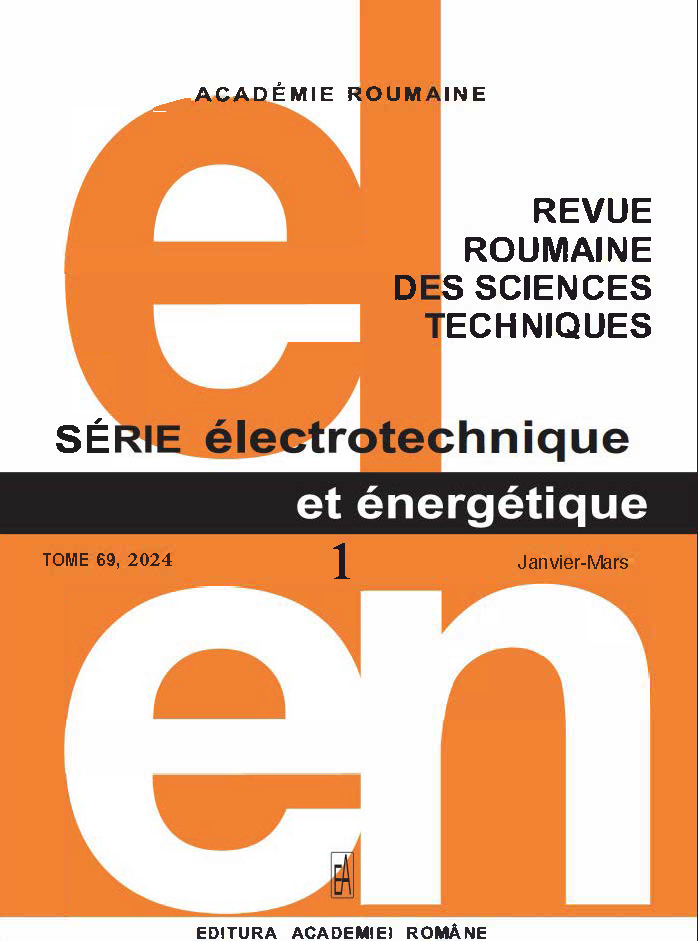NOUVEAU TYPE DE FILTRES NUMÉRIQUES À RÉPONSE IMPULSIONNELLE INFINIEDESTINÉ AU FILTRAGE DE LA PÉRIODE D'IMPULSIONS
DOI :
https://doi.org/10.59277/RRST-EE.2024.1.11Mots-clés :
Boucle verrouillée en fréquence, Filtre numérique, Boucle à verrouillage de phase, Circuit numérique, Système linéaire discretRésumé
Cet article décrit un nouveau type de filtre numérique à réponse impulsionnelle infinie (IIR) conçu pour le filtrage par période d'impulsion. Le filtre numérique IIR est conçu à l'aide d'une boucle verrouillée en fréquence IIR de troisième ordre (IIR FLL), basée sur la mesure du temps et le traitement des périodes d'entrée et de sortie. Une forme générale de l'équation aux différences décrivant ce type de FLL IIR de tout ordre est développée et comparée à l'équation aux différences correspondante des filtres numériques classiques. Les analyses mathématiques dans le domaine temporel ont été réalisées en utilisant l'approche de transformée Z et la théorie des systèmes discrets linéaires. Une analyse du filtre numérique IIR a été réalisée dans le domaine temporel et fréquentiel. Les fonctions de transfert et la transformée Z des sorties IIR FLL de troisième ordre sont développées. La partie principale de l'article est consacrée à la conception du filtre numérique IIR FLL approprié en utilisant le IIR FLL correspondant. A cet effet, la théorie du filtre numérique IIR et les outils MATLAB correspondants sont utilisés, mais en tenant compte des différences entre ces systèmes. Les capacités de filtrage du filtre numérique IIR FLL conçu sont démontrées. La simulation informatique du FLL IIR conçu est réalisée dans le domaine temporel pour permettre un aperçu précis de ses propriétés.
Références
Dj. M Perisic, "Digital filters intended for pulse signal periods", Rev. Roum. Sci. Techn. – Électrotechn. et Énerg., Vol. 67, 2, pp. 161–166, Bucarest, (2022).
Dj. M Perisic, "Frequency locked loops of the third and higher order", Rev. Roum. Sci. Techn. – Électrotechn. et Énerg., Vol. 66, No. 4 pp. 261–266, Bucarest, (2021).
Dj. M. Perisic, A. Zoric, Ž. Gavric, N. Danilovic "Digital circuit for the averaging of the pulse periods", Rev. Roum. Sci. Techn. – Électrotechn. et Énerg., Vol. 63, No. 3, pp. 300-305, (2018).
Dj. M. Perisic, M. Bojovic, "Application of Time Recursive Processing for the development of the time/phase shifter", Engineering, Technology & Applied Science Research, Vol. 7, No. 3, 1582-1587, (2017).
Dj. M. Perisic, M. Perisic, D. Mitic, M. Vasic "Time recursive Frequency Locked Loop for the tracking applications", Rev. Roum. Sci. Techn. – Électrotechn. et Énerg., Vol. 62, No. 2, pp. 195-203, Bucarest, (2015).
Dj. M. Perisic, A. Zoric, M. Perisic, V. Arsenovic, Lj. Lazic, Recursive PLL based on the Measurement and Processing of Time, Electronics and Electrical Engineering, Vol. 20, No. 5, pp. 33-36, (2014).
Dj. M. Perisic, A. Zoric, M. Perisic, D. Mitic, Analysis and Application of FLL based on the Processing of the Input and Output Periods. Automatika 57 (1), ISSN 0005-1144, DOI 10.7305, p. 230–238 (2016).
Dj. M Perisic, M. Bojovic, Multipurpose Time Recursive PLL, Rev. Roum. Sci. Techn. – Électrotechn. et Énerg., Vol. 61, 3, pp. 283-288, Bucarest, (2016).
Dj. M Perisic, M. Perisic, S. Rankov, Phase Shifter based on a recursive Phase Locked Loop of the second order, Rev. Roum. Sci. Techn. – Électrotechn. et Énerg., 59, 4, pp. 391–400, (2014).
Dj. M. Perisic, A. Zoric, Dj. Babic, Dj. Dj. Perisic, Decoding and Prediction of Energy State in Consumption Control, Rev. Roum. Sci. Techn. – Electrotechn. et Energ., 58, 3, pp. 263–272, Bucarest, (2013).
D. Jovcic, Phase locked loop system for FACTS, IEEE Transaction on Power System, 18, pp. 2185-2192 (2003).
A. S. N. Mokhtar,B. B. I.Reaz, M. Maruffuzaman, M. A. M. Ali, Inverse park transformation using Cordic and Phase-Locked Loop, Rev. Roum. Sci.Techn.-Electrotechn. Et Energy., 57, 4, pp. 422-431, (2012).
C. C. Chung, An all-digital phase-locked loop for high speed clock generation, IEEE Journal of Solid-State Circuits, 38, Issue 2, pp. 347-359 (2003).
F. Amrane, A. Chaiba, B. E. Babes, S. Mekhilef, Design and implementation of high performance field oriented control for grid-connected doubly fed induction generator via hysteresis rotor current controller, Rev. Roum. Sci. Techn. Et Energy., Vol. 61, 4, pp. 319–324, (2016).
M. Büyük, M. İnci, M. Tümay, Performance comparison of voltage sag/swell detection methods implemented in custom power devices, Rev. Roum. Sci. Techn. – Electrotechn. et Energ., Vol. 62, 2, pp. 129–133, (2017).
L. Joonsuk and B. Kim, A low noise fast-lock phase-locked loop with adaptive bandwith control-Solid-State Circuit, IEEE Journal, Vol. 35, Issue 8, pp. 1137-1145, (2000).
D. Abramovitch, Phase-locked loops: a control centric tutorial, American Control Conference-2002, Proceedings of 2002, Vol 1, pp. 1-15, (2002).
R. Vich, Z Transform Theory and Application (Mathematics and Applications), Ed. Springer, (1987-first edition).
S. W. Smith, Digital Signal Processing (second edition), California Technical Publishing, (1999)
G. Bianchi, Phase-Locked Loop Synthesizer Simulation, Nc-Hill, Inc. New York, USA, (2005).
W. F. Egan, Phase-Lock Basics (second edition), John Wiley and Sons, (2008).
B. D. Talbot, Frequency Acquisition Techniques for PLL, Wiley-IEEE Press, (2012).
C. B. Fledderman, Introduction to Electrical and Computer Engineering, Prentis Hall, (2002).
M. Gardner, Phase lock techniques, Hoboken, Wiley-Interscience, (2005).
S. Winder, Analog and Digital Filter Design (second edition), Copyright©2002 Elsevier Inc., (2002).
Téléchargements
Publiée
Numéro
Rubrique
Licence
(c) Copyright REVUE ROUMAINE DES SCIENCES TECHNIQUES — SÉRIE ÉLECTROTECHNIQUE ET ÉNERGÉTIQUE 2024

Ce travail est disponible sous licence Creative Commons Attribution - Pas d'Utilisation Commerciale - Pas de Modification 4.0 International.


